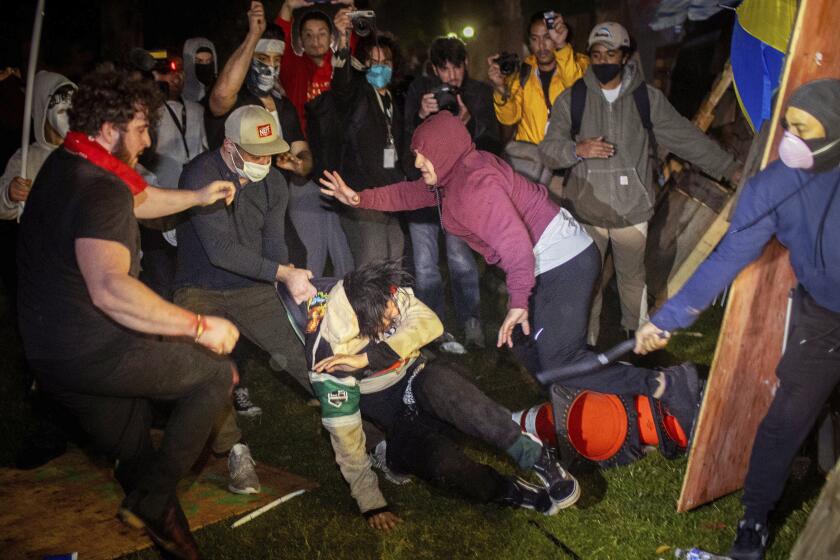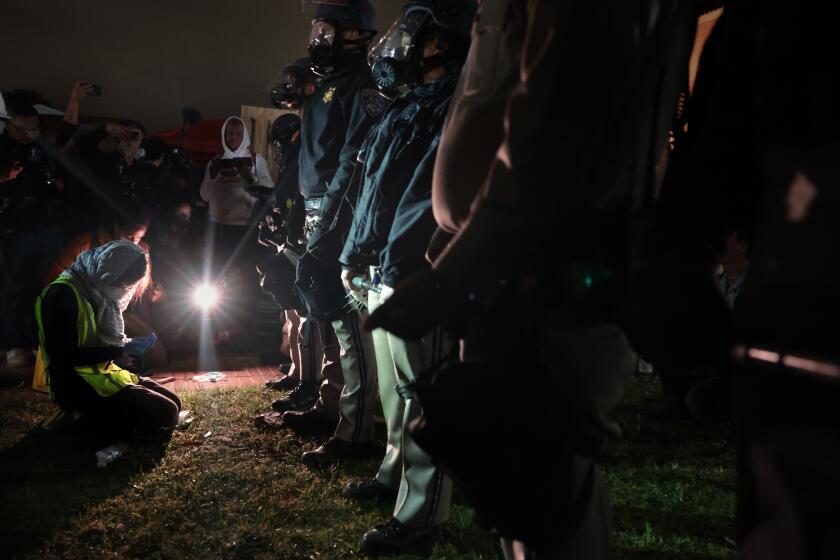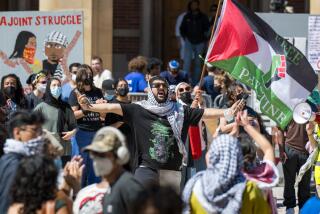Who were the masked men behind the UCLA camp attack? Online sleuths vow to find out
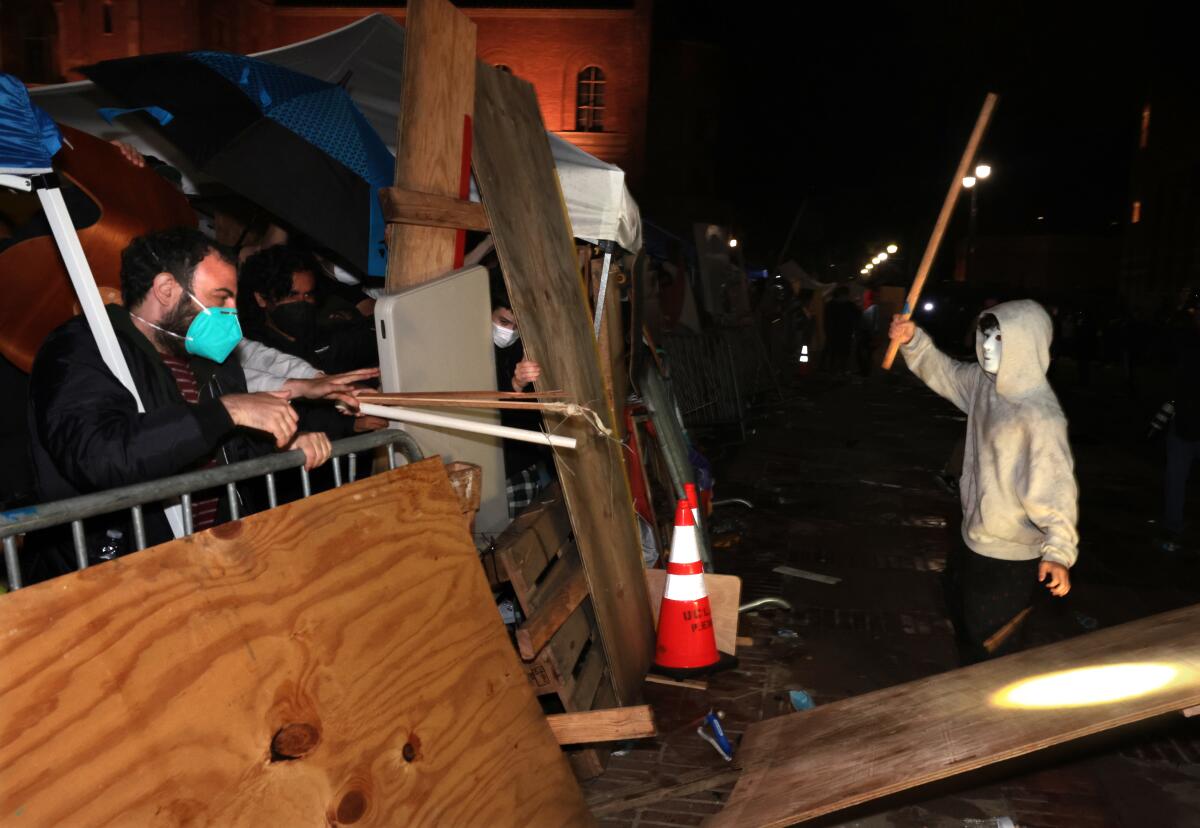
- Share via
The online sleuths got to work within hours of violence sparking at UCLA this week.
They grabbed videos of the mostly masked rioters who attacked the pro-Palestinian student encampment near the quad and tried to zoom in on faces. They pored over each frame, waiting for the moment masks slipped and faces were exposed to take screen grabs. Then, they uploaded those faces to X (formerly Twitter), Instagram and other social media platforms and beseeched the internet to do its thing.
From across the country and around the world, people logged on and joined the collective research effort.
Soon, the alleged perpetrators’ names, and in some cases identifying details such as places of employment, were posted online along with photos. License plates from cars owned by alleged pro-Israel counterprotesters were also posted.
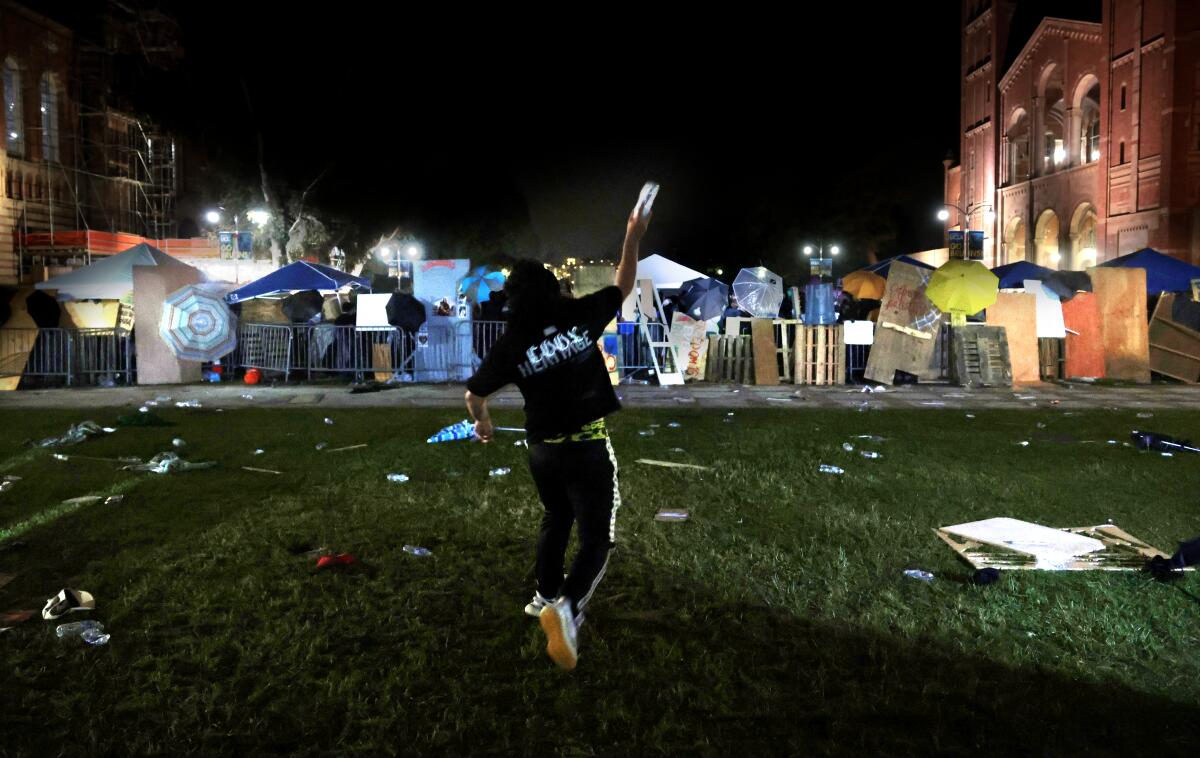
Law enforcement officials, including the U.S. attorney’s office in Los Angeles, declined to comment on the tactic. But some who study extremism said the online effort to identify and expose the alleged perpetrators of the violence at UCLA is one more sign of the polarization of civil society in the current moment: People don’t trust the justice system to investigate or deliver justice, and they are taking it upon themselves.
Photos: Clashes erupt at pro-Palestinian demonstrations on California campuses
“This is where we’re at now,” said Brian Levin, the founding director of the Center for the Study of Hate and Extremism at Cal State San Bernardino. “People feel for their own protection that they have to bring their own goggles [to protests to protect from tear gas], and they also have to find their own assailants.”
He added, “Here’s the problem: Sometimes the doxing is wrong.”
Doxing — posting someone’s name, address and other identifying data — has been going on as long as people have been online. But it gained prominence as a tactic after the Unite the Right march in Charlottesville, Va., in 2017, when people crowdsourced the identities — sometimes incorrectly — of participants in the white nationalist rally.
Then came Jan. 6, 2021, when thousands of people stormed the U.S. Capitol. A loosely organized group of online sleuths — known as “Sedition Hunters” — dedicated themselves to identifying them and turning their names over to the FBI.
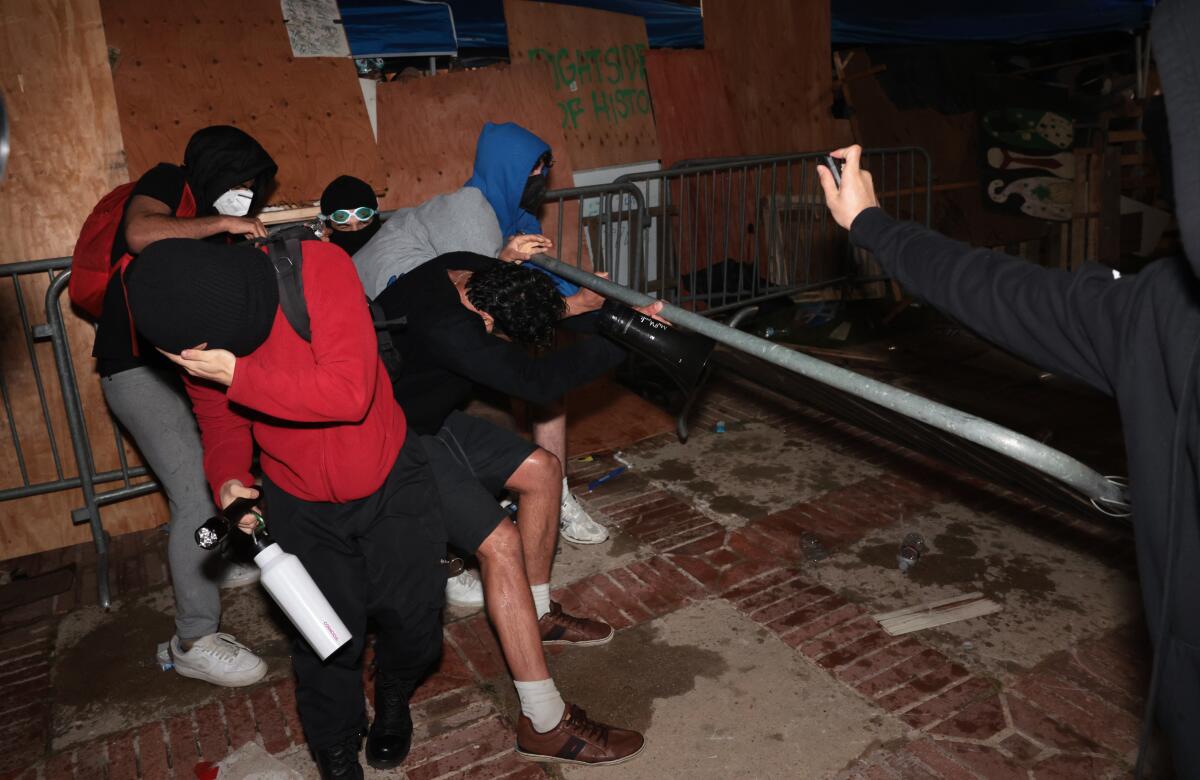
When a large group of men wearing black outfits and white masks stormed into the UCLA encampment Tuesday evening, pro-Palestinian groups almost immediately began trying to identify them.
“Can anyone identify this man at @UCLA?,” one post read. “He struck an activist in the head with a wooden plank, before punching and kicking another person.”
“If you recognize this man, please dm me. He pepper-sprayed me,” read another post on Instagram.
It took hours for police to push away counterprotesters and bring calm to UCLA’s campus, raising questions about whether the campus was prepared.
“Identify this criminal,” another person posted on Instagram, over a photograph of a man in a black T-shirt with a red scarf momentarily lowered to reveal his face. “The main culprit behind the brutal assault on our allies at UCLA last night. *Note: Lawyers will deal with him once he is identified. NOT us. All we need is his name.”
Shortly thereafter, the business website of a Los Angeles man who had been named as one of the attackers was mobbed with angry reviews. Others who had been identified rushed to make their social media profiles private, turned off comments on their business pages and set their phones to send all calls to voicemail.
In some cases, the online doxing was quickly followed by apologies for identifying the wrong person.
“Kindly disregard,” one person wrote on Instagram after blasting out a name. Another photograph was tagged with a few different names (with no clarity on which name was the right one).
The Times is not naming any of the people identified online. Reporters attempted to reach several of them, but their messages were not returned.
Despite the risks of sending an angry online mob after innocent people, some students at the encampment said they felt they had no choice.
“We would like to protect ourselves by making these people known,” said 26-year-old Nicolette on Wednesday inside UCLA’s encampment. She said she endured hours of terror as the men threw fireworks into the camp, blasted them with pepper spray and threw objects at them.
Nicolette added that many pro-Palestinian students have also been doxed, their names put on websites. For that reason — and to stave off repercussions from university officials —many students in pro-Palestinian encampments around the country this week have also been masked. And, like Nicolette, they have refused to share their full names with reporters.
Jenna, a 21-year-old UCLA student, said that before things turned violent, a group of about 10 people showed up, all wearing white masks, an action she believed “was definitely coordinated.” About 11 p.m., she said, black trucks pulled up, older men came out and a huge mob started heading toward the encampment.
Another woman, who referred to herself as “Nicky” and who had been at the encampment since Thursday, said students have turned to group chats to share photos and identify some of those responsible.
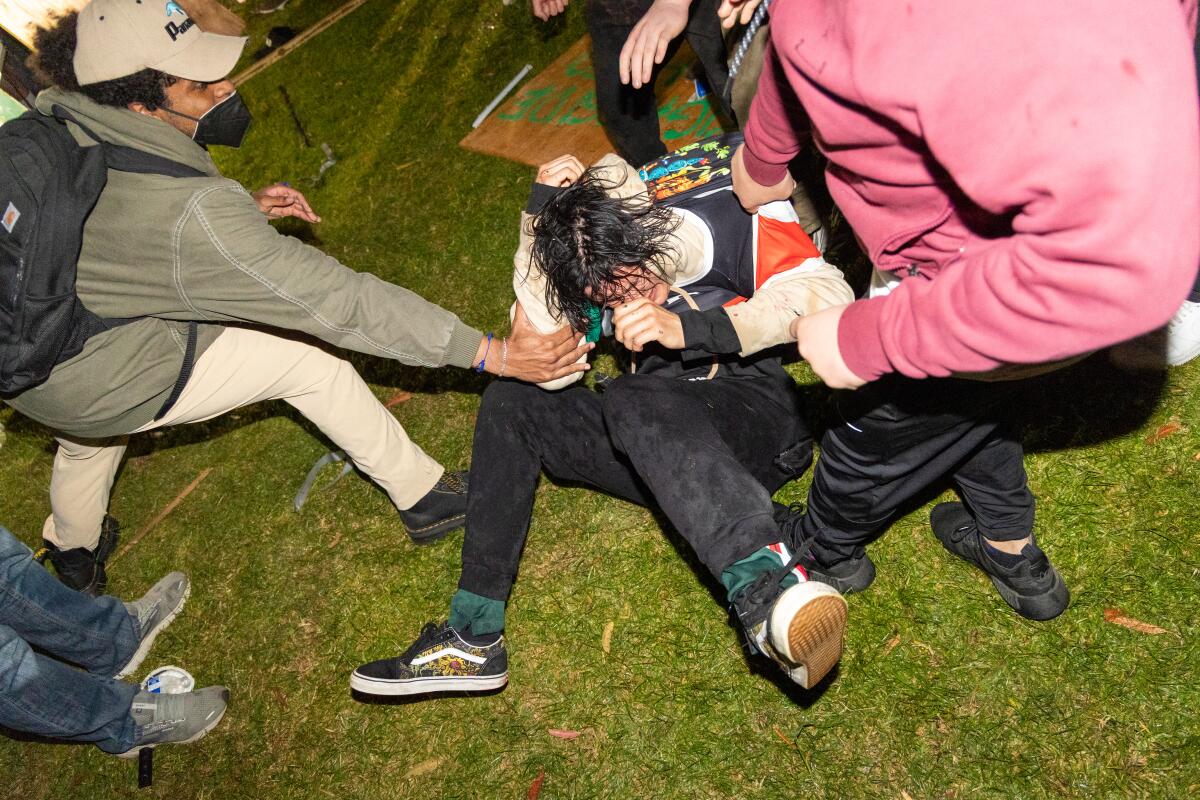
In part, she said, they took it upon themselves because they did not expect campus police or authorities to seek out and identify the counterprotesters.
“Here, they allowed them to terrorize us all night long and did nothing,” she said. The 37-year-old said law enforcement, possibly California Highway Patrol officers, showed up briefly and “drove off like it was none of their business.”
In group chats, people circulated addresses and phone numbers of counterprotesters. In the case of a man waving a large yellow flag that read “Moshiach” — Messiah — those on the pro-Palestinian side watched him walk to his car and were able to see his license plate. The man had worn a black mask as he shouted “we fear nobody but God. God’s Army.”
“We’re going to see what his license plate is, because we’re going to get his identity tonight,” someone narrated on a video as they followed him to snap a picture. “He thinks that he’s safe, that no one’s going to find out what his identity is. That’s why he was acting so bold.”
Officials, including the UCLA Police Department and the Los Angeles Police Department, have said little about their efforts to identify and arrest the men who unleashed violence on the protesters at UCLA. Mayor Karen Bass, who rushed back to Los Angeles when the violence broke out, said she was demanding a “full investigation.”
Many on campus and outside UCLA are criticizing the university for not handling the violent counterprotest better.
“Those involved in launching fireworks at other people, spraying chemicals and physically assaulting others will be found, arrested, and prosecuted, as well as anyone involved in any form of violence or lawlessness,” she said in a statement.
Around the encampment, the theories on who was responsible spread fast and furious. Some believed that the counterprotesters were paid agitators. Others believed the melee was a crime of opportunity. The majority of those on the pro-Palestinian side insisted that the counterprotesters were not students.
Hussam Ayloush, executive director of the Council on American-Islamic Relations office in Los Angeles, called the agigators “pro-Israel extremists” and said attorneys at CAIR are “exploring all legal avenues to hold the perpetrators of these terroristic attacks accountable.”
Ayloush said CAIR is asking for those who were harmed to contact its offices and submit reports and evidence, “so we can help take the necessary action.”
Times staff writer Matthew Ormseth contributed to this report.
More to Read
Sign up for Essential California
The most important California stories and recommendations in your inbox every morning.
You may occasionally receive promotional content from the Los Angeles Times.

